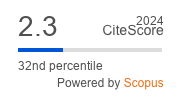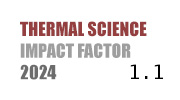ABSTRACT
Coal kaolin, as an important industrial raw material, is used in the production of artificial Molochite sand whose application is of great potential for high-end castings due to its ability to significantly reduce the cost of mineral sand and improve the quality of sand mold. In this paper, the key factors in the calcination of coal kaolin were systematically analyzed with a three-factor, four-level orthogonal test, and the test factors were rotary kiln temperature, particle size, and residence time of materials. The optimal calcination parameters determined by range analysis were a temperature of 1500ºC coal kaolin, a particle size of 4mm-8mm, and residence time of 1.5 hours. Analysis of variance showed that temperature had the most significant effect on the calcination effect, followed by coal kaolin particle size. In contrast, the effect of residence time of materials was relatively small. The test showed that the basic needs of producing 60% mullite, the standard percentage, could be met at 1100ºC. In order to verify the required coal feed and temperature distribution in the actual rotary kiln, a rotary kiln model was established by numerical simulation technology to simulate the actual conditions. The results showed that the rotary kiln has an average temperature of 1159ºC and a maximum temperature of 1428ºC when the coal consumption is 1.5 kg/s, which meets the temperature requirements for 60% mullite.
KEYWORDS
PAPER SUBMITTED: 2024-10-19
PAPER REVISED: 2024-12-23
PAPER ACCEPTED: 2024-12-27
PUBLISHED ONLINE: 2025-02-16
- Liu, Y., et al., Assessment of pozzolanic activity of calcined coal-series kaolin, Applied Clay Science, 143 (2017), pp. 159-167
- Bu, X., et al., Removal of fine quartz from coal-series kaolin by flotation, Applied Clay Science, 143 (2017), pp. 437-444
- Xu, X., et al., Microstructural evolution, phase transformation, and variations in physical properties of coal series kaolin powder compact during firing, Applied Clay Science, 115 (2015), pp. 76-86
- Ptáček, P., et al., The kinetics of Al-Si spinel phase crystallization from calcined kaolin, Journal of Solid State Chemistry, 183 (2010), 11, pp. 2565-2569
- Ondro, T., et al., Kinetic analysis of sinter-crystallization of mullite and cristobalite from kaolinite, Thermochimica Acta, 678 (2019), p. 178312
- Yuan, S., et al., Effects of carbonaceous matter additives on kinetics, phase and structure evolution of coal-series kaolin during calcination, Applied Clay Science, 165 (2018), pp. 124-134
- Chargui, F., et al., Mullite fabrication from natural kaolin and aluminium slag, Boletín De La Sociedad Española De Cerámica Y Vidrio, 57 (2018), 4, pp. 169-177
- Chen, C., Tuan, W., Evolution of Mullite Texture on Firing Tape-Cast Kaolin Bodies, Journal of the American Ceramic Society, 85 (2002), 5, pp. 1121-1126
- Liu, X. Y., Specht, E., Mean residence time and hold-up of solids in rotary kilns, Chemical Engineering Science, 61 (2006), 15, pp. 5176-5181
- Bojanovský, J., et al., Rotary Kiln, a Unit on the Border of the Process and Energy Industry—Current State and Perspectives, Sustainability, 14 (2022), 21, p. 13903
- Gürtürk, M., et al., CFD analysis of a rotary kiln using for plaster production and discussion of the effects of flue gas recirculation application, Heat and Mass Transfer, 54 (2018), 10, pp. 2935-2950
- Ariyaratne, W. K. H., et al., CFD modelling of meat and bone meal combustion in a cement rotary kiln - Investigation of fuel particle size and fuel feeding position impacts, Chemical Engineering Science, 123 (2015), pp. 596-608
- Huang, Y., et al., Numerical simulation of pulverized coal combustion in rotary kilns with different oxygen concentrations, Energy Sources. Part a, Recovery, Utilization, and Environmental Effects, 44 (2022), 2, pp. 4510-4524
- Xia, S., et al., The application of orthogonal test method in the parameters optimization of PEMFC under steady working condition, International Journal of Hydrogen Energy, 41 (2016), 26, pp. 11380-11390
- Vuthaluru, R., Vuthaluru, H. B., Modelling of a wall fired furnace for different operating conditions using FLUENT, Fuel Processing Technology, 87 (2006), 7, pp. 633-639
- Xu, J., et al., A Soft Sensor Modeling of Cement Rotary Kiln Temperature Field Based on Model-Driven and Data-Driven Methods, Ieee Sensors Journal, 21 (2021), 24, pp. 27632-27639
- Cecílio, D. M., et al., Industrial Rotary Kiln Burner Performance with 3D CFD Modeling, Fuels, 4 (2023), 4, pp. 454-468
- Rahman, A., et al., Recent development on the uses of alternative fuels in cement manufacturing process, Fuel (Guildford), 145 (2015), pp. 84-99
- Bäckström, D., et al., On the use of alternative fuels in rotary kiln burners — An experimental and modelling study of the effect on the radiative heat transfer conditions, Fuel Processing Technology, 138 (2015), pp. 210-220
- Kobayashi, H., et al., Coal devolatilization at high temperatures, Symposium (International) On Combustion, 16 (1977), 1, pp. 411-425
- Wang, B., Kao, H., Numerical simulation of O2/CO2 combustion in decomposition furnace, Thermal Science, 27 (2023), 5 Part B, pp. 4307-4320
- Wang, G., et al., Numerical simulation of pulverized coal combustion in a rotary kiln under O2/CO2 atmosphere, Thermal Science, 27 (2023), 6 Part B, pp. 4935-4945
- Wang, M., et al., Numerical simulation of oxy-coal combustion in a rotary cement kiln, Applied Thermal Engineering, 103 (2016), pp. 491-500
- Cecílio, D. M., et al., Industrial Rotary Kiln Burner Performance with 3D CFD Modeling, Fuels, 4 (2023), 4, pp. 454-468

